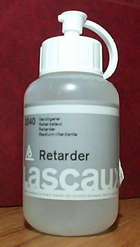My Experiences with Acrylic Retarder
![]()

What is it?
|
|
Acrylic is made up of pigment, which provides the colour, and a colourless medium which binds the particles of pigment to the object being painted. The medium used in acrylic dries very quickly, even when mixed with water. This means that you will rarely be hanging around waiting for it to dry, but is a problem when trying to blend, as this process relies on the paint not being fully dry. Retarder is a clear substance which prevents the acrylic from drying so quickly. It can be bought from most good art shops. This one came from the Canonbury Art Shop, Upper Street, Islington and cost £4.40. I have heard that glycerin will have the same effect, but I didn't have any and couldn't be bothered to experiment.
|
|
Usage
|
|
The most appropriate use for retarder is blending because you need to mix two or more colours before the first has gone rock solid. Transluscency Problem This isn't too much of a problem when shadowing a base coat, but with highlighting there is more of a problem. The pale colour will not cover properly and the colours will tend to look rather grey and washed out. The effect is difficult to describe, but you will know it when you see it. To make the transluscency less of a problem it is often best to make the base coat at the lighter end of the spectrum being shaded. You could also try taking some of the highlighting shade without any retarder in it and apply blobs of it to the raised areas before starting the blending process. This way all the paint with retarder in it will be darker than the underlying colour. Mixing in the retarder Mixing with one colour only |
Verdict
|
|
I haven't found the end results are noticeably better, but retarder can definitely speed up the process of blending by assisting in the continual battle to avoid an area drying out before it is finished. It also does make it slightly easier to get a smooth blend once you have become acclimatised to the transluscency problem. Retarder does seem to present as many problems as it solves, and it would be all too easy for the novice painter to end up with a muddy mess. Give it a go, but don't expect an easy shortcut to beautiful blending.
|
